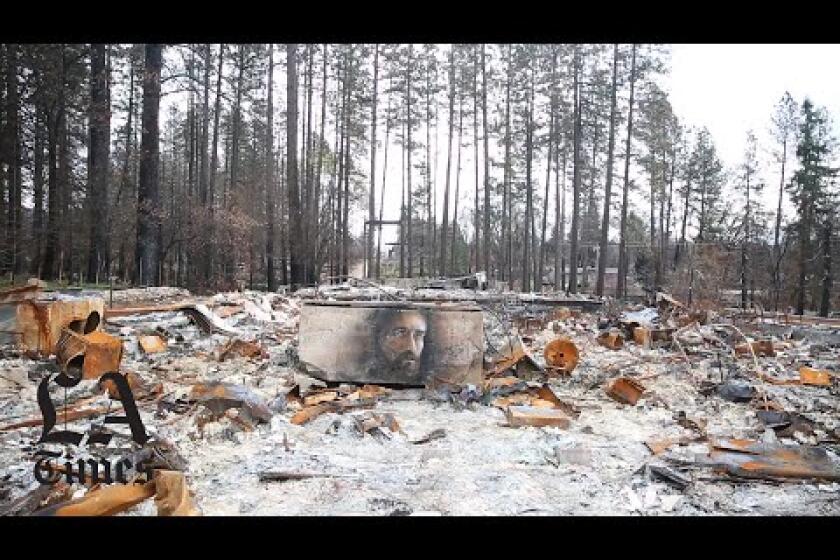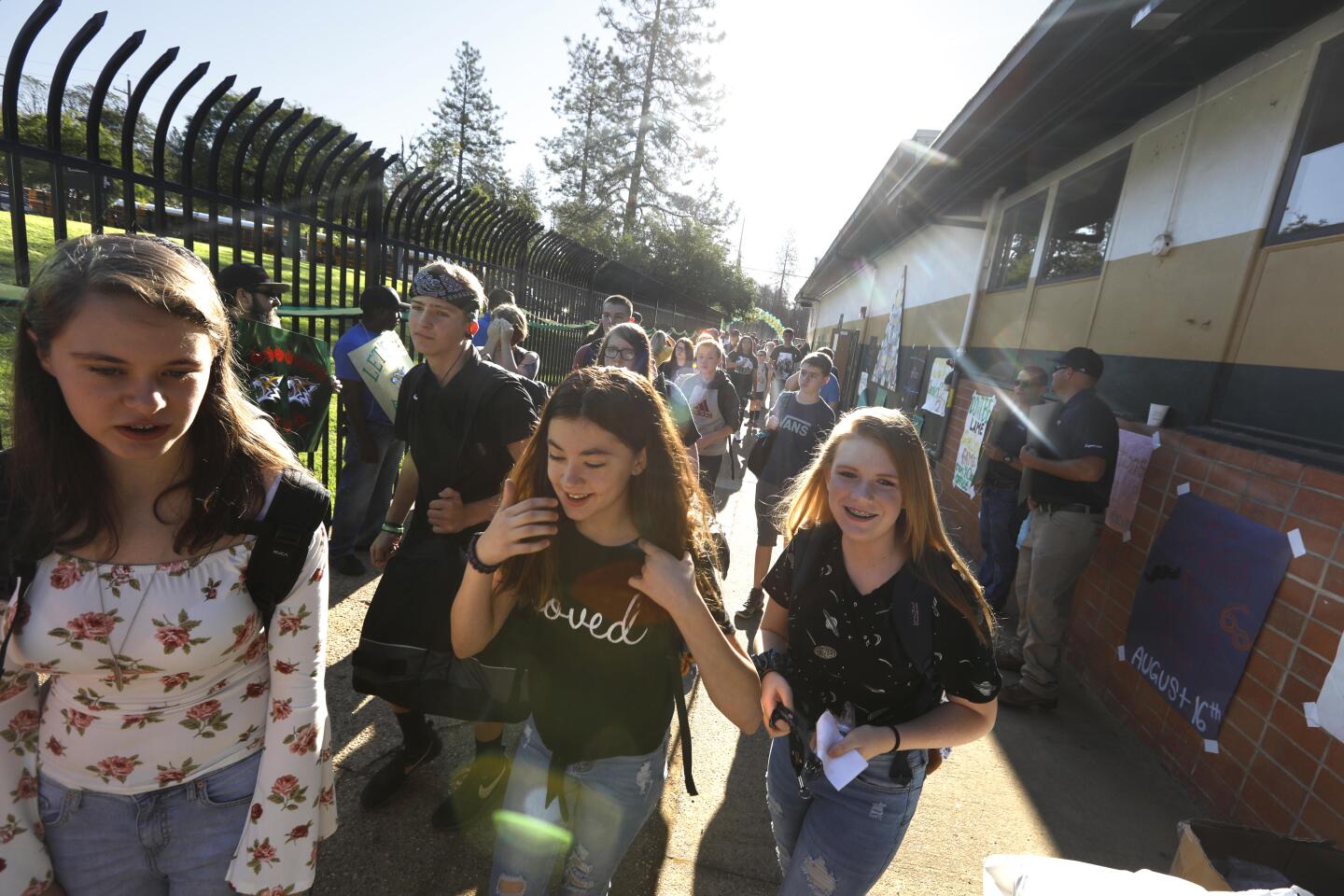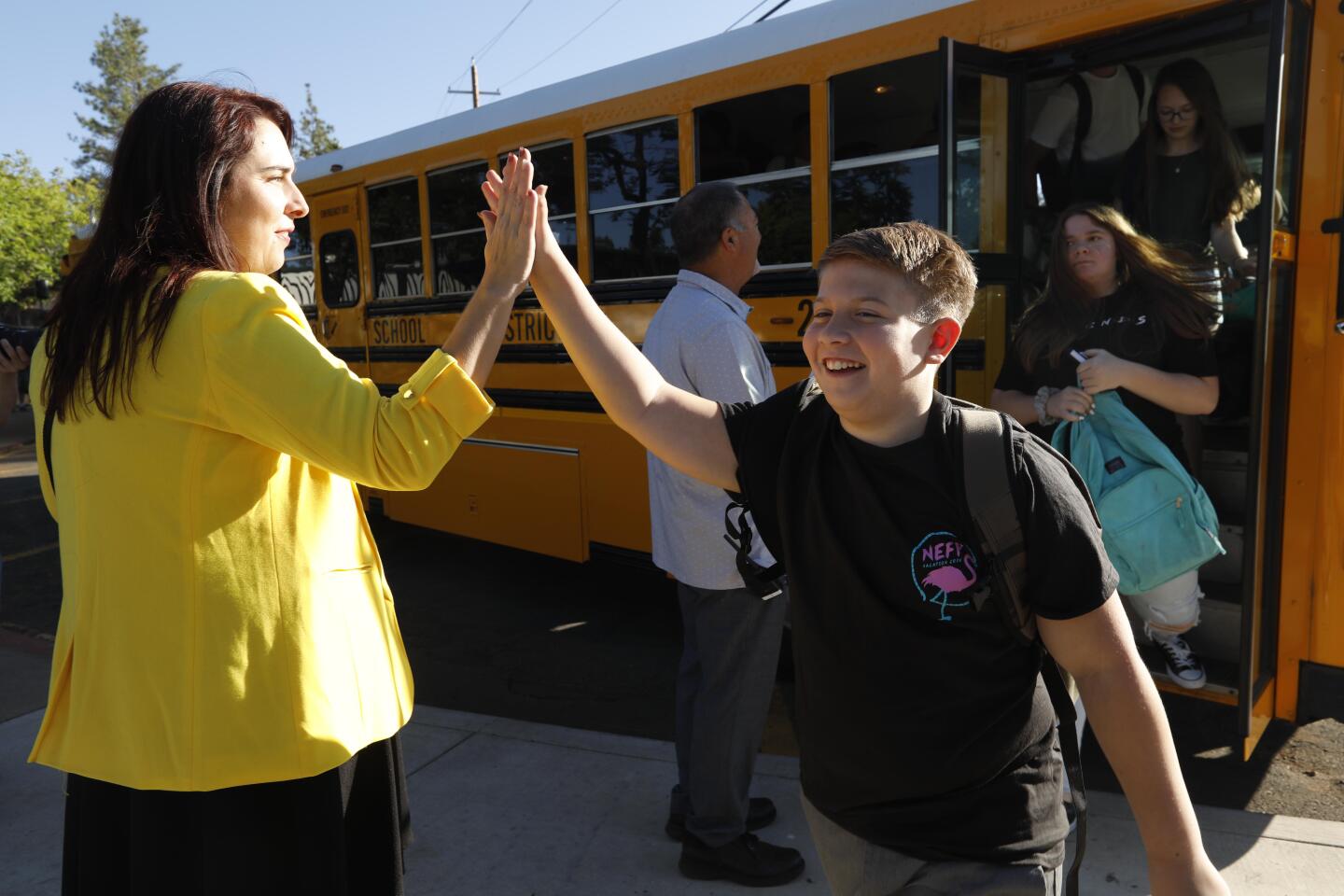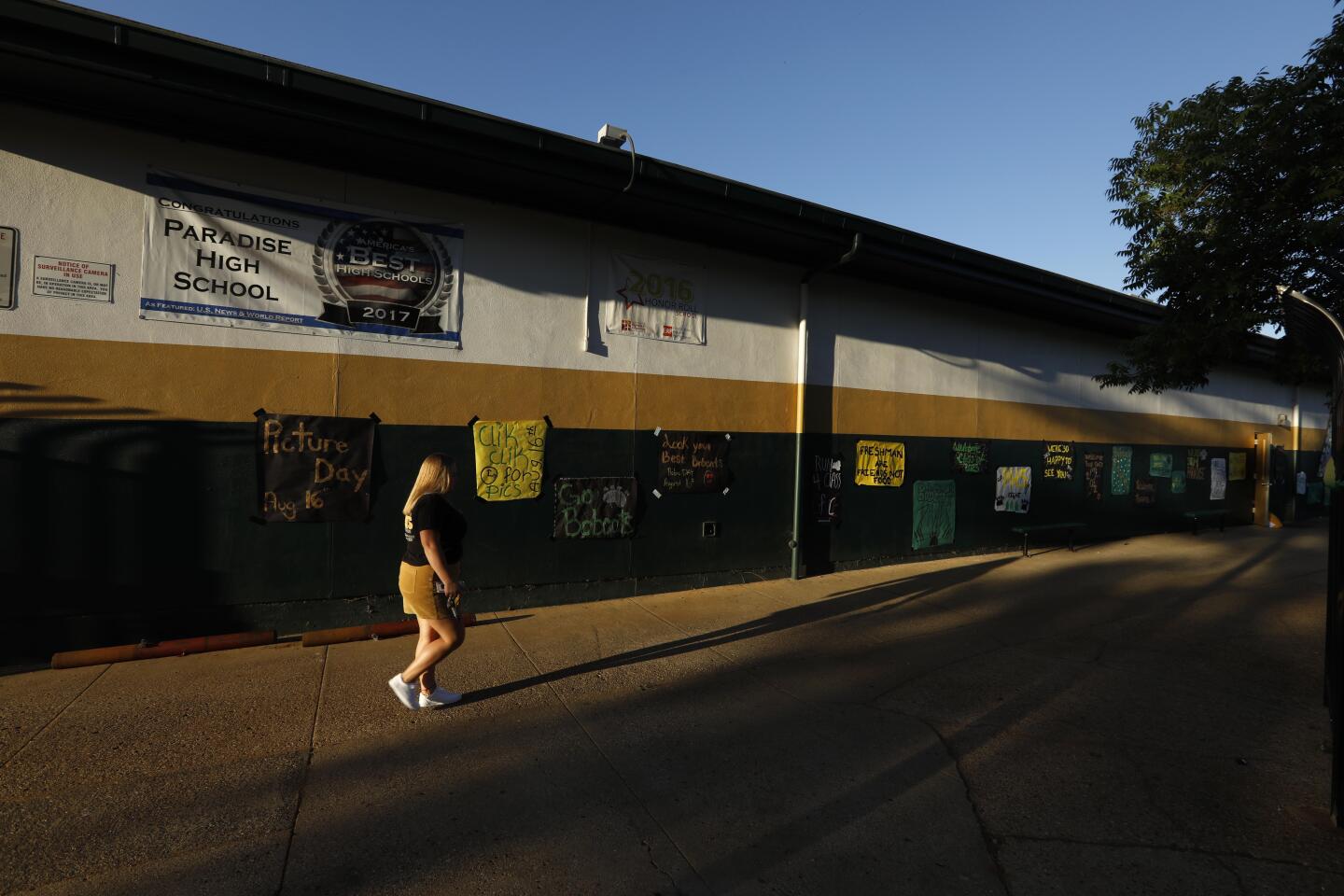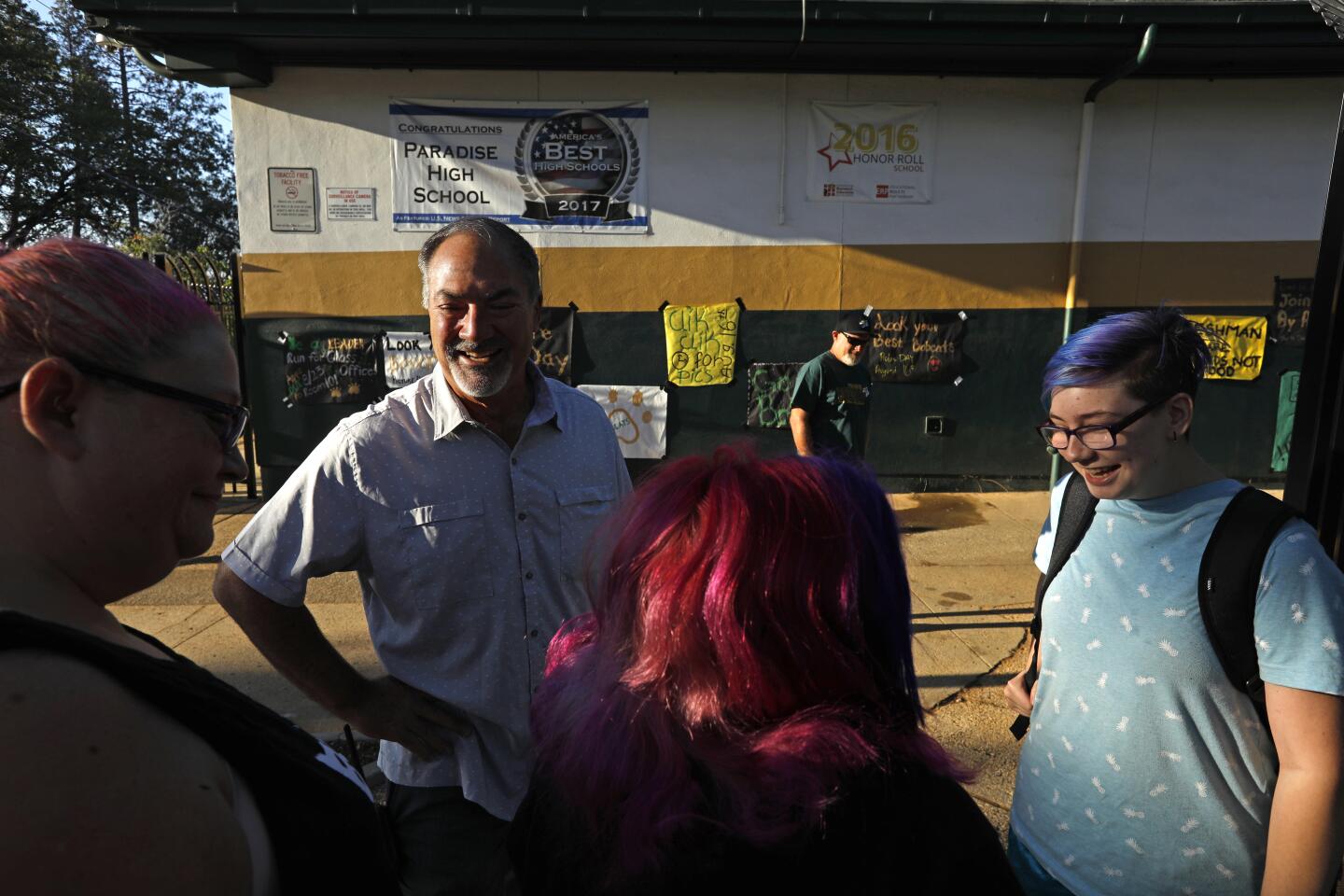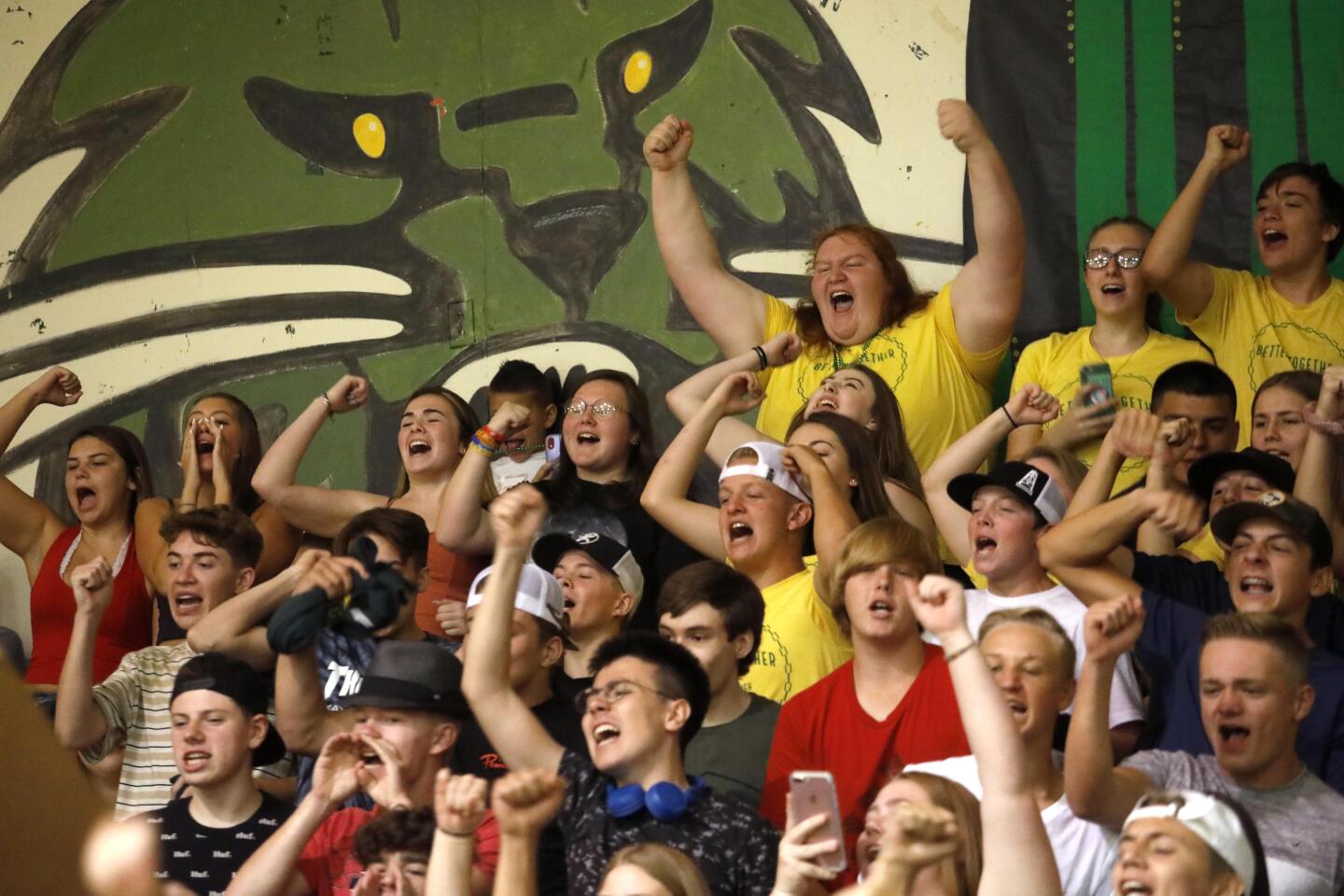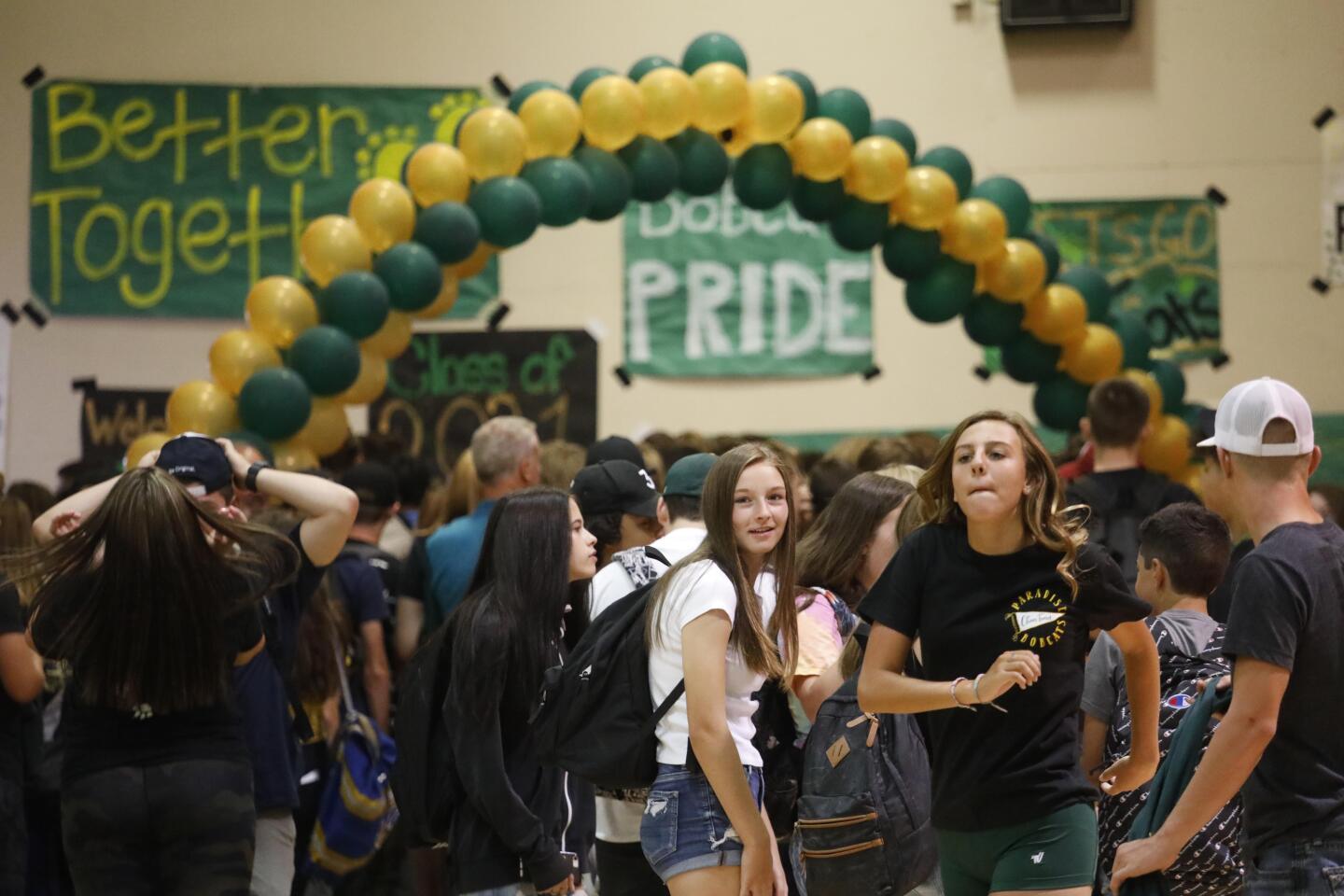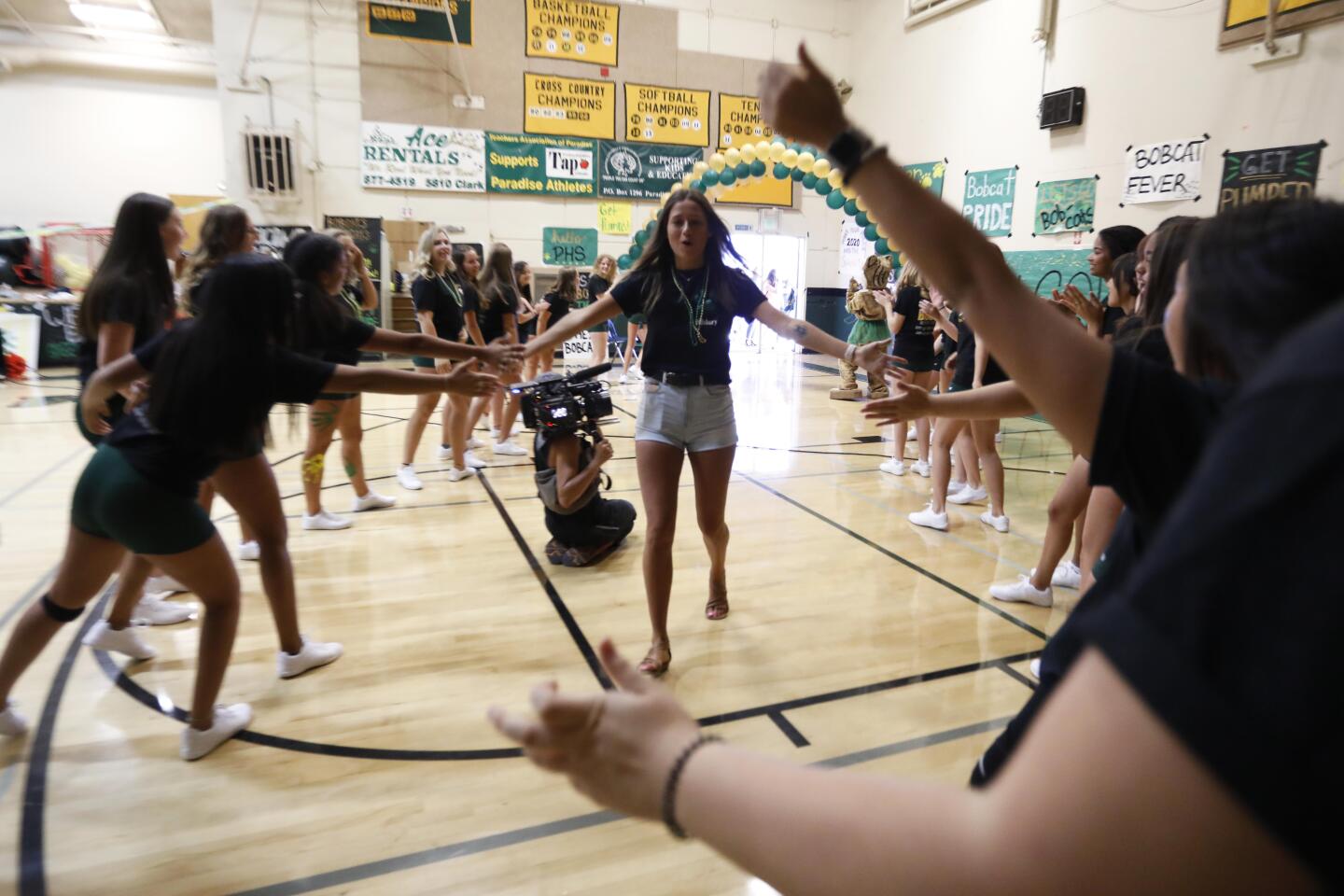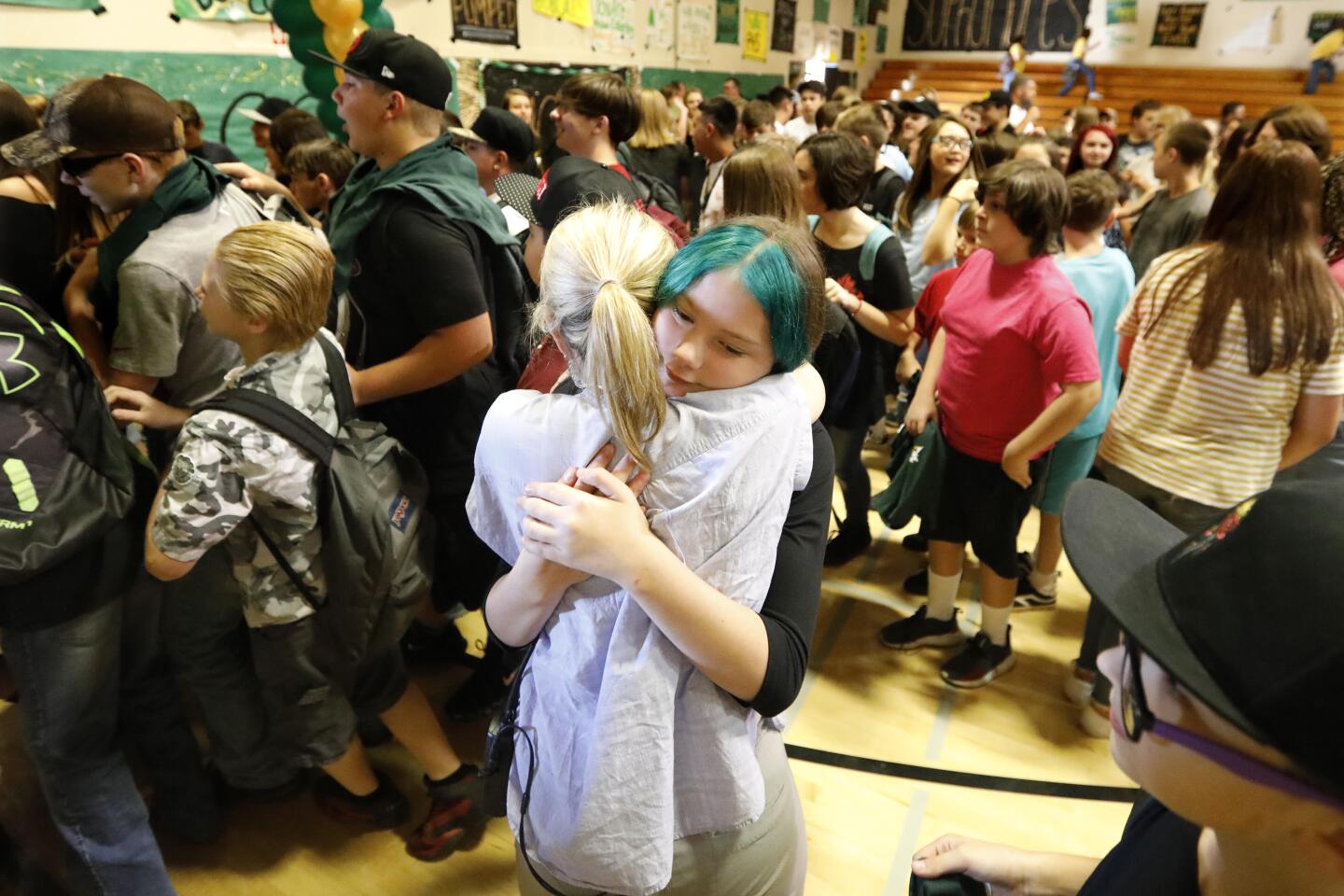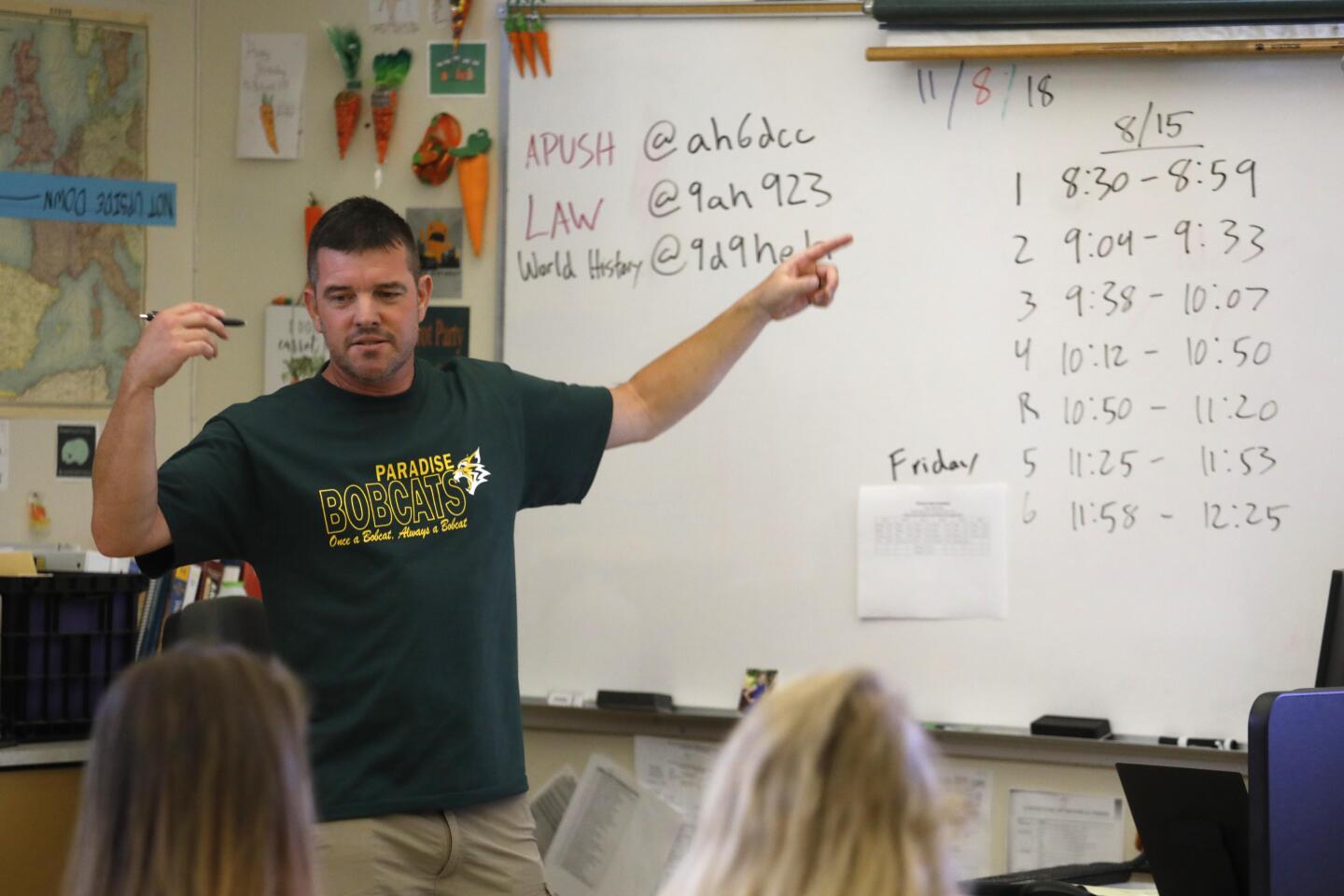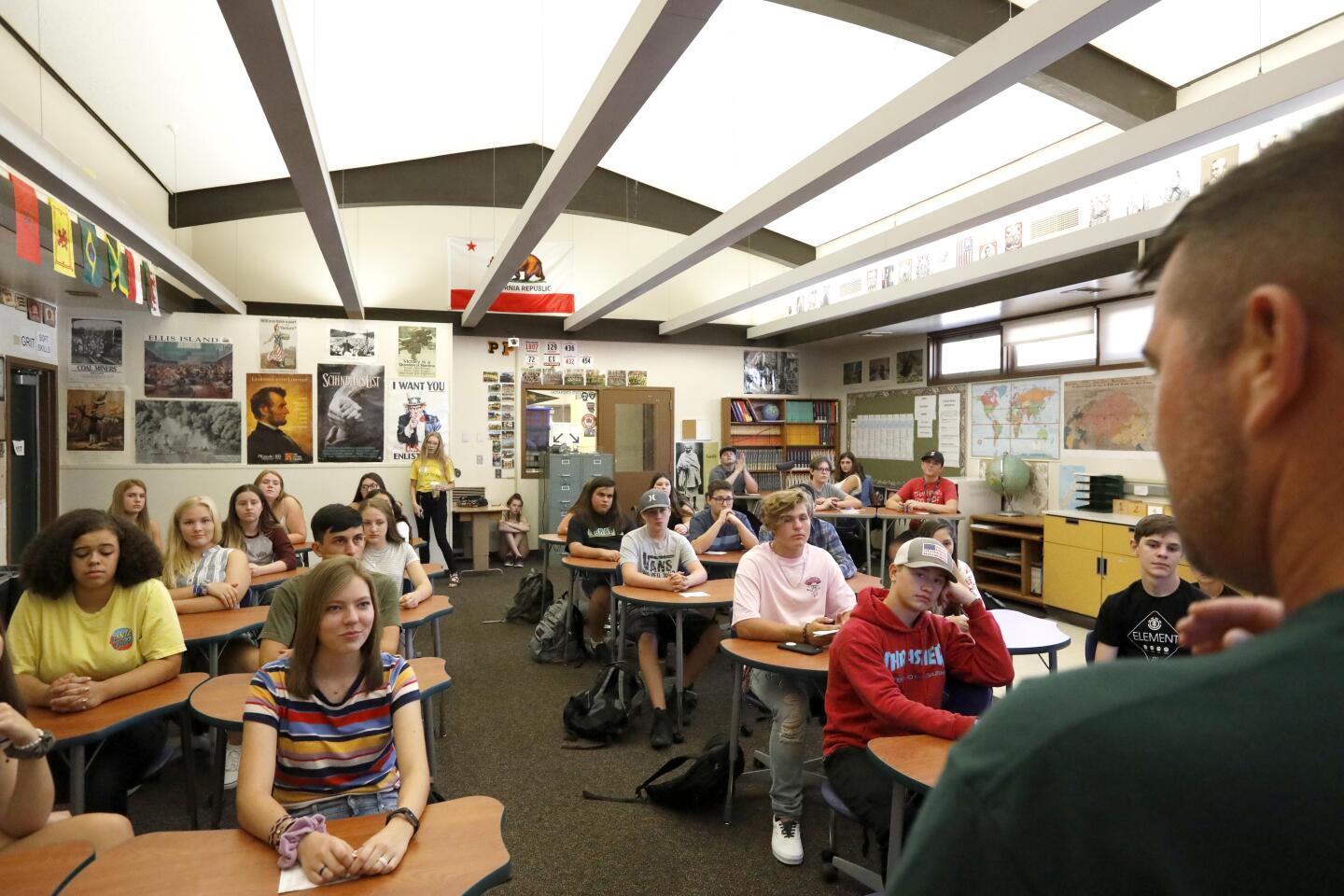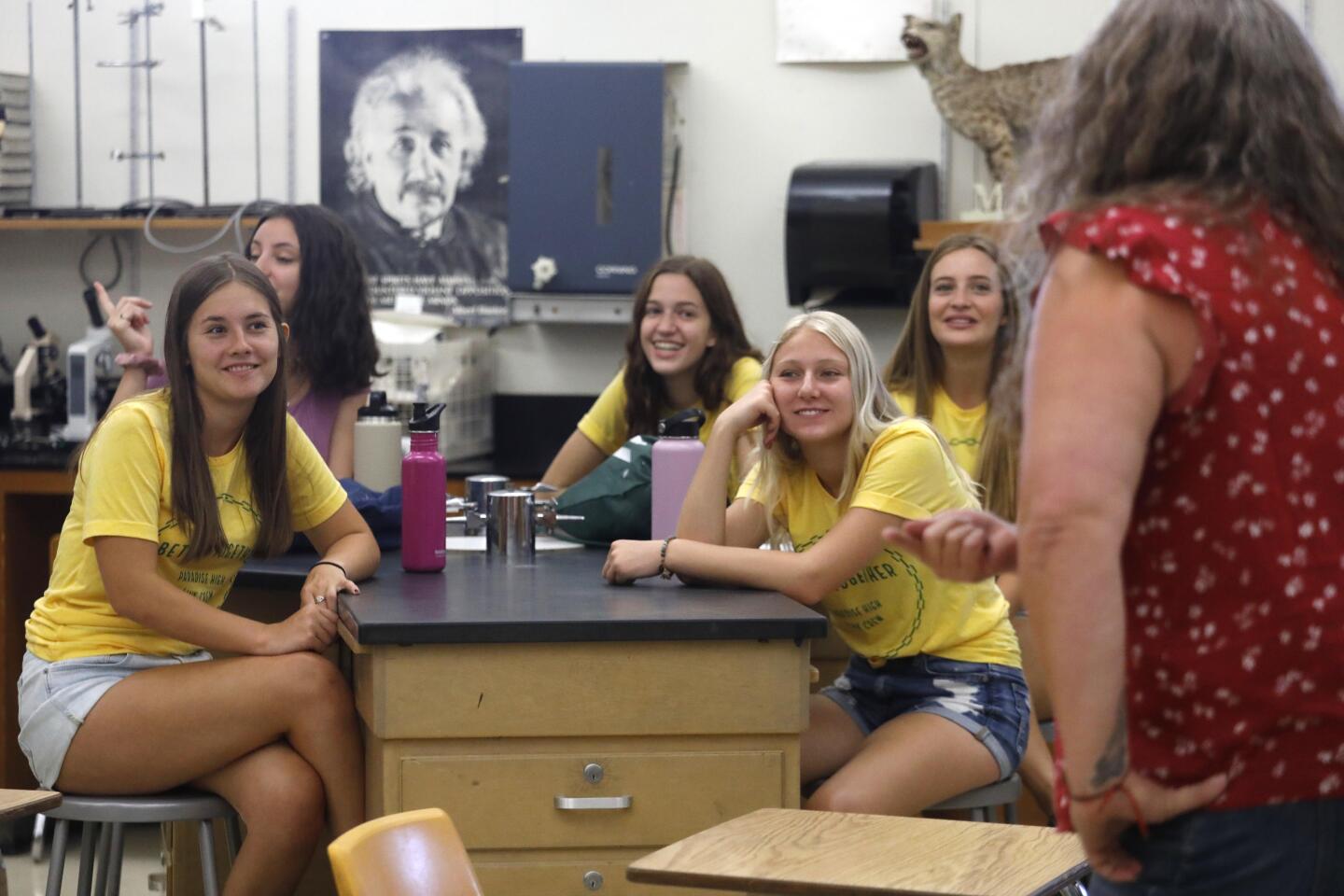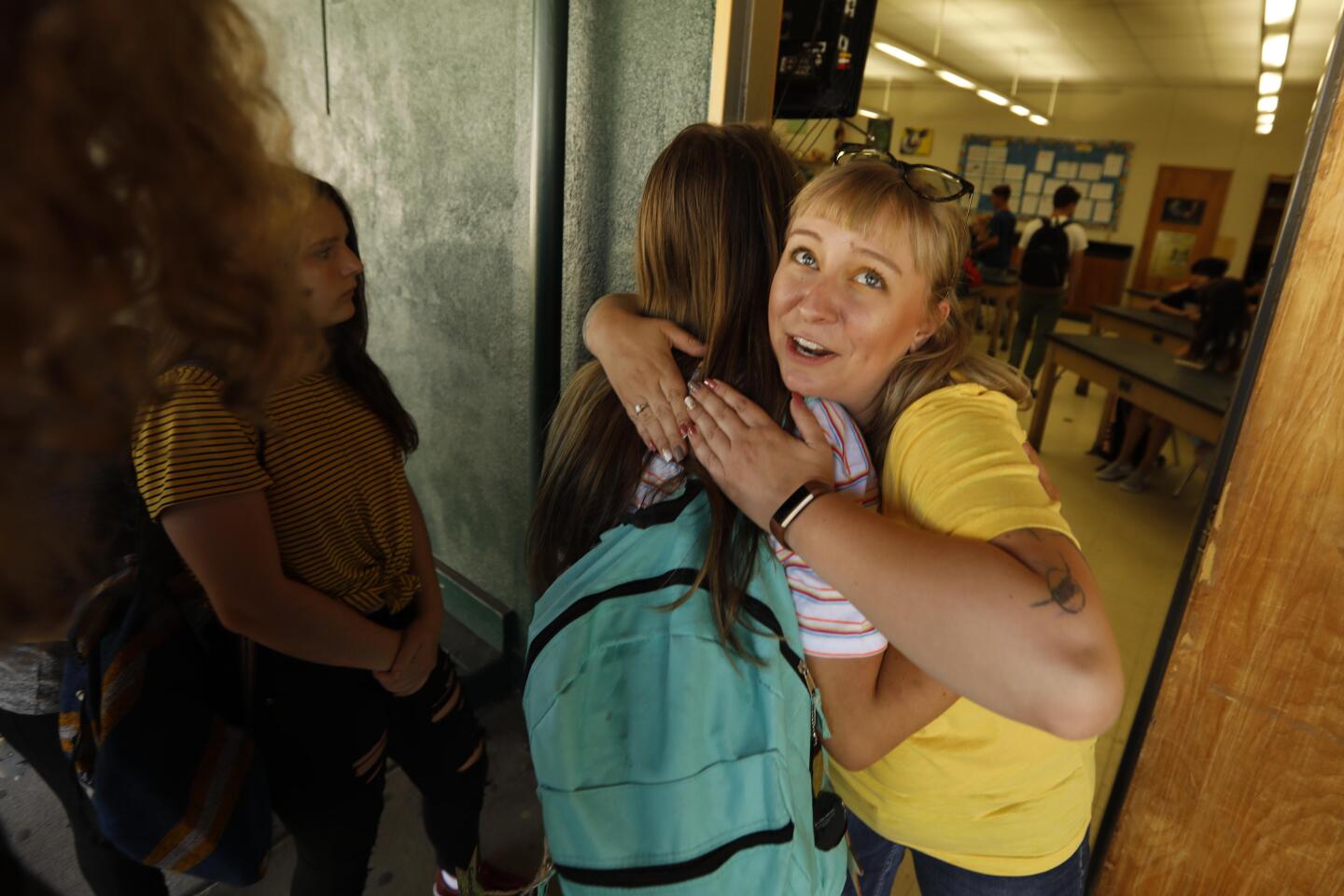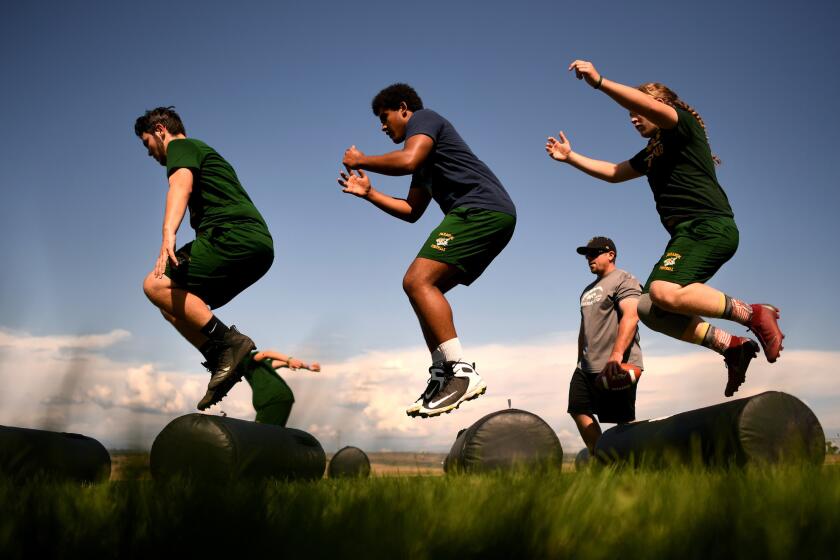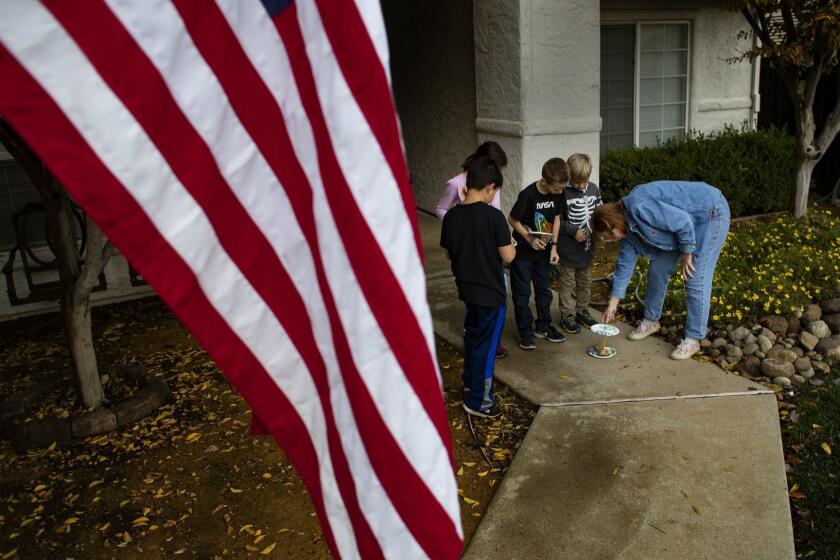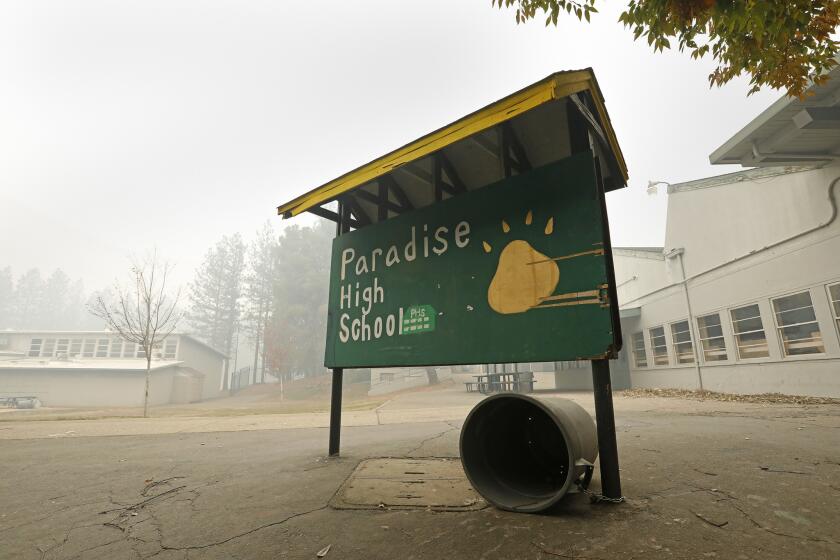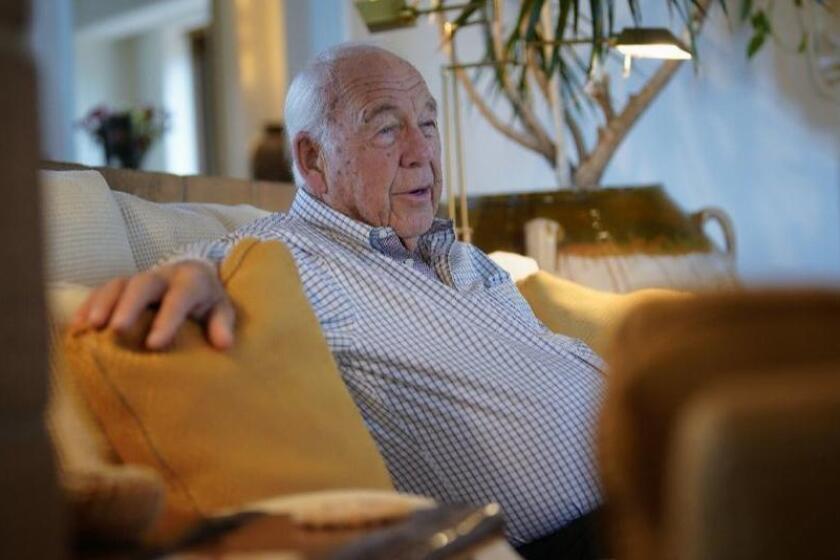After the fire in Paradise, a bittersweet back-to-school for a town still reeling
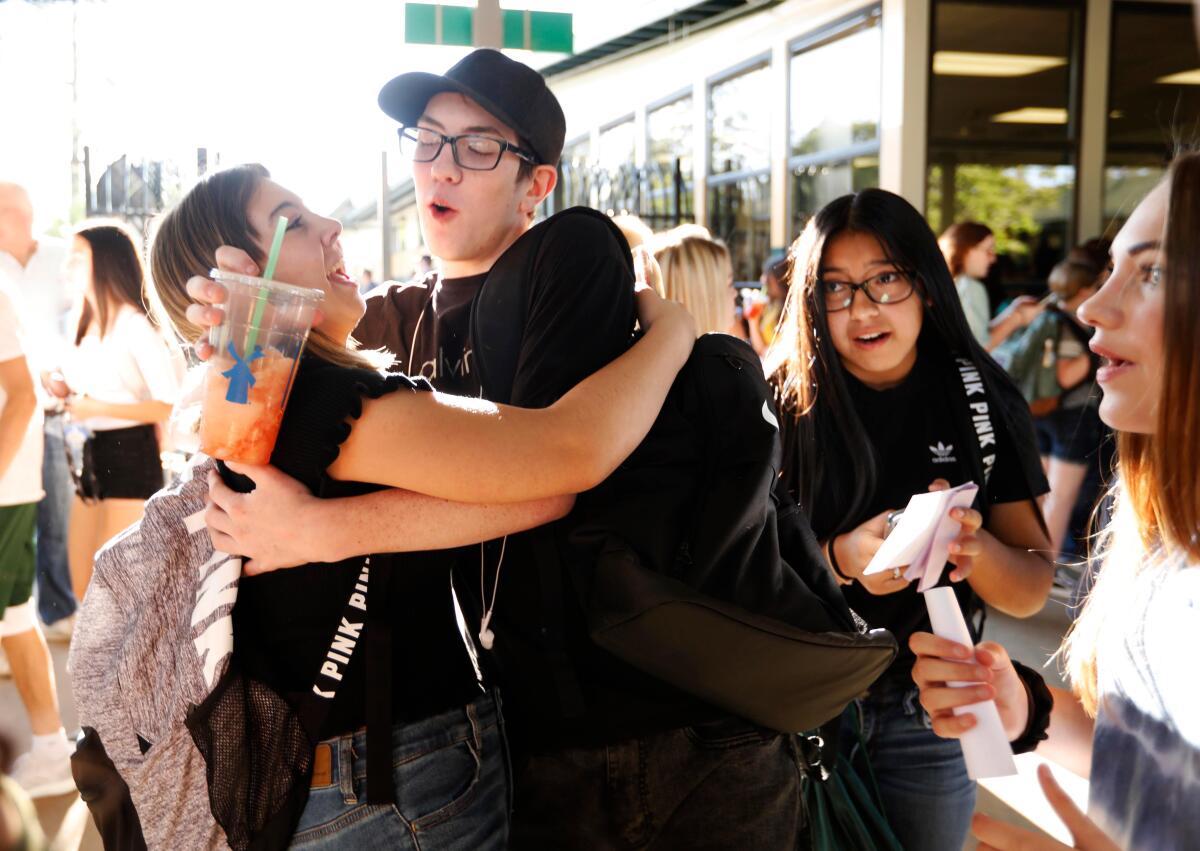
- Share via
PARADISE, Calif. — No one has yet erected an official memorial on the Paradise High School campus to mark the hideous fire that burned down most of this town in November. But the signs are here.
Scorched pines ring the expanse behind one end of the football field. A burned stump outside the campus has been carved into the school’s bobcat mascot. And in Room 117, where Josh Bullock teaches social studies, there’s another marker of the day no one can forget. The date on the whiteboard reads, “11/8/18.”
“I didn’t have the heart to erase it when I came back here in January or February,” Bullock told his students Thursday. “We are all still dealing with that day in some way. We are all in different places. So I am going to leave it up for today … and then at the end of the day, I am going to erase it. And then we are going to move on.”
The moving on began this week as students and teachers returned to Paradise’s public schools, a significant infusion of life for a town that all but disappeared nine months ago. Reconstruction still lags and debris-removal trucks fill the roads, but the return of students and teachers marked the beginning of what many here hope will be a rebirth.
“I believe that the schools are the cornerstone. You are not going to have a town if you don’t have families. And you are not going to have families if you don’t have good schools,” said Michelle John, superintendent of the Paradise Unified School District. “If you asked me, I think it’s everything.”
Recognizing the magnitude of the homecoming, teachers mostly put off teaching, to let students hug and enjoy one another.
“I have never had friends in any other town like I have here in Paradise,” said Bradley Norton, a senior whose family moved briefly back to the Sacramento area after the fire. “When we moved to the city, it just confirmed for all of us how much we wanted to be back up here.”
It’s a measure of the devastation here that Paradise lost four of its nine campuses — two elementary schools, a continuation high school and an adult school — and yet the damage seemed mild. That’s in comparison to a town that lost about 90% of its homes and saw its population drop from 27,000 to roughly 2,000.
On the first day of school, the two shuttered elementary schools had merged on what was once the middle school campus, while seventh- and eighth-graders shifted to the Paradise High School campus. Paradise High returned to its historic campus, an island in a scorched landscape.
Early estimates suggest it will cost $50 million to replace the school district’s lost structures. For now, the campuses have received some fresh paint and new water systems, to filter any pollutants that may have seeped out of thousands of burned structures. A more comprehensive building program will have to wait until the district can assess how many students it will need to accommodate.
That remains a work in progress, with many families delaying decisions about rebuilding. Thursday, an unexpected crush of students pushed attendance to 1,500, more than the 1,200 expected but far short of the 3,400 enrolled before the Camp fire.
The Camp fire destroyed their town. Now the Paradise High football team is trying to save themselves
The hills that stretch above this grassy pasture were once ablaze, an apocalyptic fire consuming their homes, disrupting their families, melting their childhoods.
California has suffered so many fire calamities that these formerly once-in-a-lifetime events have become routine enough to be recognized by the state’s budget makers. A series of firestorms in the fall of 2017 burned more than 6,000 structures and killed 44 people in the wine country at the north end of San Francisco Bay. Afterward, California lawmakers agreed to assure that communities hit by fire devastation did not suffer an additional loss: the reduction of school funding as students fled to other communities.
Those rules assure that Paradise Unified will suffer no major cuts to its roughly $40-million annual budget either this year or next year. After that, the school district’s funding will be reduced commensurate with what is expected to be a substantially smaller student population.
Uncertainty has been a way of life here since that day — marked on the classroom whiteboard — when 50-mph winds catapulted flames through Paradise and neighboring communities. Some 14,000 homes burned and 86 people died, both records for California wildfires.
The fire left Paradise High smoke-damaged and inaccessible to students, whose families mostly moved to the Sacramento Valley. The school remained closed for three weeks before shifting into drop-in “labs” at the Chico Mall, with most schoolwork completed online. After the winter holidays, the high school reopened, but in a converted warehouse at Chico Municipal Airport. That meant students packed together in “classrooms” separated only by temporary partitions.
The sounds of wood shop, gym classes and random conversations echoed through a building that became known as “the Fortress.” The name came from a nearby street but also could have applied to a state of mind. More than one student recalled feeling “caged” at the temporary campus.
Sheri Eichar spent the summer decorating her third-grade classroom at Children’s Community Charter School in Paradise, Calif., like a beach resort.
“After everything we have been through and overcome, I am so excited to be here,” senior Shannon Moakley said Thursday after a loud morning pep rally in the gym. Her family decamped for several months to Texas, before she led the push for them to come home. “This campus is like home to me.”
Moakley and fellow students said they look forward to traditions like the sunrise breakfast Friday morning. Seniors will gather on blankets on the campus’ front lawn. Soon, late-night bonfires will return and, late this month, football. “It’s exactly the way I thought it would be,” Moakley said. “It’s exactly what I hoped for.”
But some losses can’t be ignored. The vast majority of students are now commuters, from apartments and homes spread around the Sacramento Valley. Teachers said they are on the lookout for signs of trauma, and every campus now has at least two counselors, ready to deal with post-fire stress. A school district staff that once numbered 400 has been reduced to 250. Beloved teachers — uncertain what would become of their jobs when state-guaranteed funding ends two years from now — have moved on.
Social studies teacher Brady Velikonia lived his entire life in Paradise and waited seven years after getting his teaching credential for a position to open up at his alma mater. But with job uncertainty and the prospect of another fire, he and his wife and three daughters have moved to Bend, Ore.
“For me, this was like the Big One that never happened but now it did, and there is a real possibility it could happen again. It might take another 15 years, but I wouldn’t want to be here,” Velikonia said. “You can’t put that toothpaste back in the tube.”
Those who stayed say they don’t judge those who left. But many of the teachers at Paradise said they feel an obligation to offer students an island of consistency and calm.
The score of the Friday night football game last month between the Paradise High School Bobcats and the Shasta High School Wolves was tied at 7.
“I am super proud of all of you. You could have made other choices, but you chose to stick with us and to be here,” science teacher Wendy Marsters told her third-period class Thursday. “I really think the high school is the heart of this community, and you are a part of that.”
Marsters, beginning her 23rd year at the school, wears a tattoo on her wrist of a campfire, the smoke forming a heart. It’s a symbol that “love is thicker than smoke,” she told her students. Since the fire, drives up the ridge to Paradise had been filled with sadness until the return of her students, Marsters said.
“I am super excited to be something familiar and dependable and reliable for my students,” she said. “And I am super excited to be part of the rebuilding of Paradise and to support kids who are going through things that most people have never experienced.”
Residents of the mostly white Sierra foothill community span the economic spectrum, but they’re poor enough that, before the fire, about 65% of the high school’s students qualified for subsidized lunches. To some lowlanders, “we have always been like the crazy mountain folk, like Hicksville, USA,” said Hannah Sperske, a senior and member of the school’s leadership program. But locals wear that label proudly, Sperske said, adding: “We will just keep going. Doing our thing.”
Thursday, that thing included a pair of pep rallies: one for the newly arrived middle schoolers, one for high school students. Teachers played a game that had them dancing and shimmying. Students stomped on balloons in a frantic relay race. A few select senior boys were chosen for a “fashion show,” traipsing across the gym floor in their favorite women’s wear. The crowd maintained a persistent din.
Leading the proceedings was Jeff Marcus, the school’s former principal, who agreed to come out of retirement when Principal Loren Lighthall announced last spring he could not find housing for his family (including seven children) and had to move on.
With many of their homes damaged or destroyed in the state’s most devastating wildfire, the students of Paradise High School face an uncertain future.
“We have an unbreakable bond. We have been through something which nobody else has been through,” Marcus told the rally, to more cheering. “Now the eyes of the world are on us. Let’s show the world what Paradise is all about.”
Bullock said he, too, thought about moving to a more stable school district but changed his mind.
“I just decided I wanted to see this all the way through,” he said. “To see what Paradise High School is going to be, after all this. It felt like the right thing to do.”
More to Read
Sign up for Essential California
The most important California stories and recommendations in your inbox every morning.
You may occasionally receive promotional content from the Los Angeles Times.

